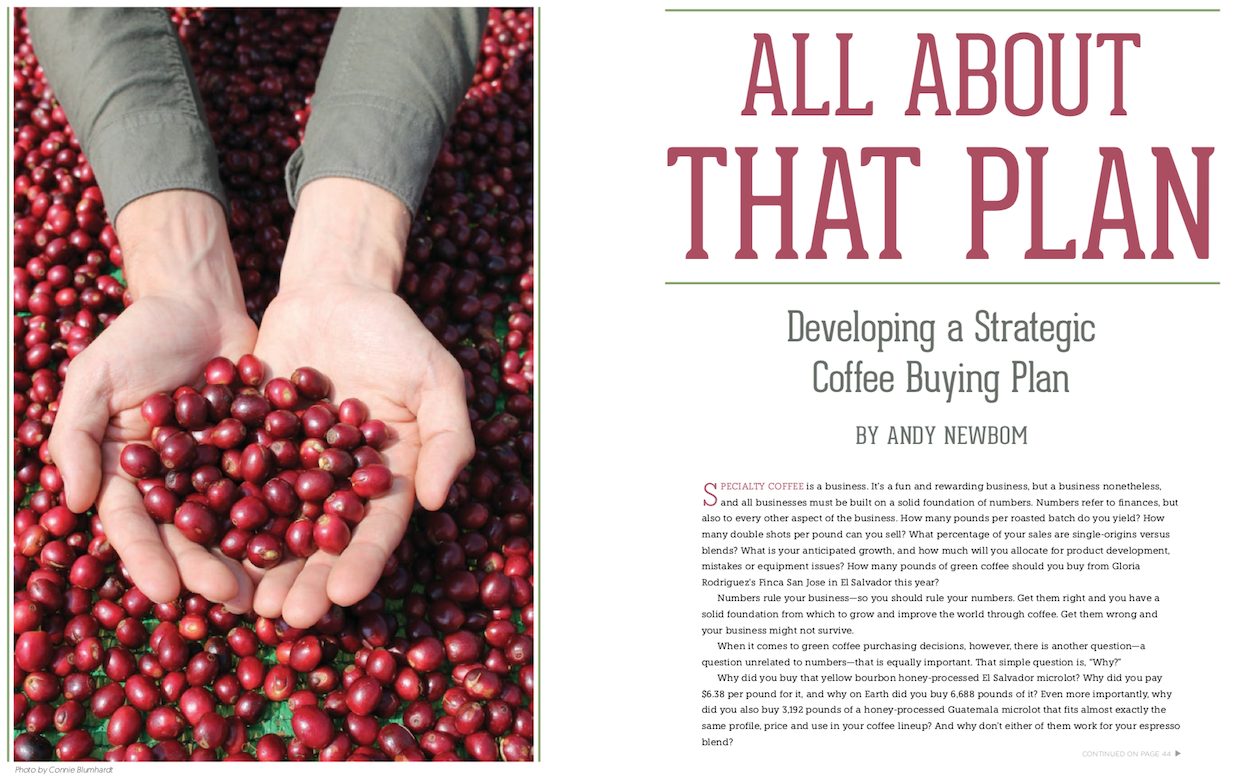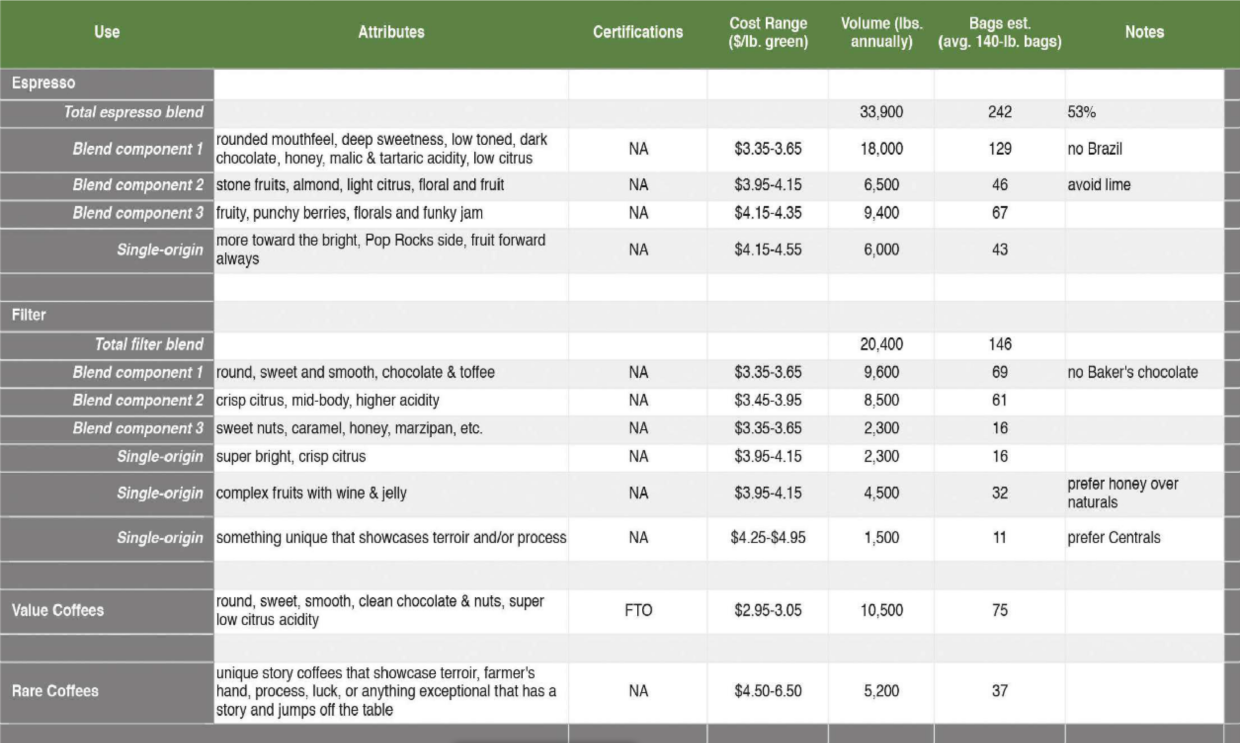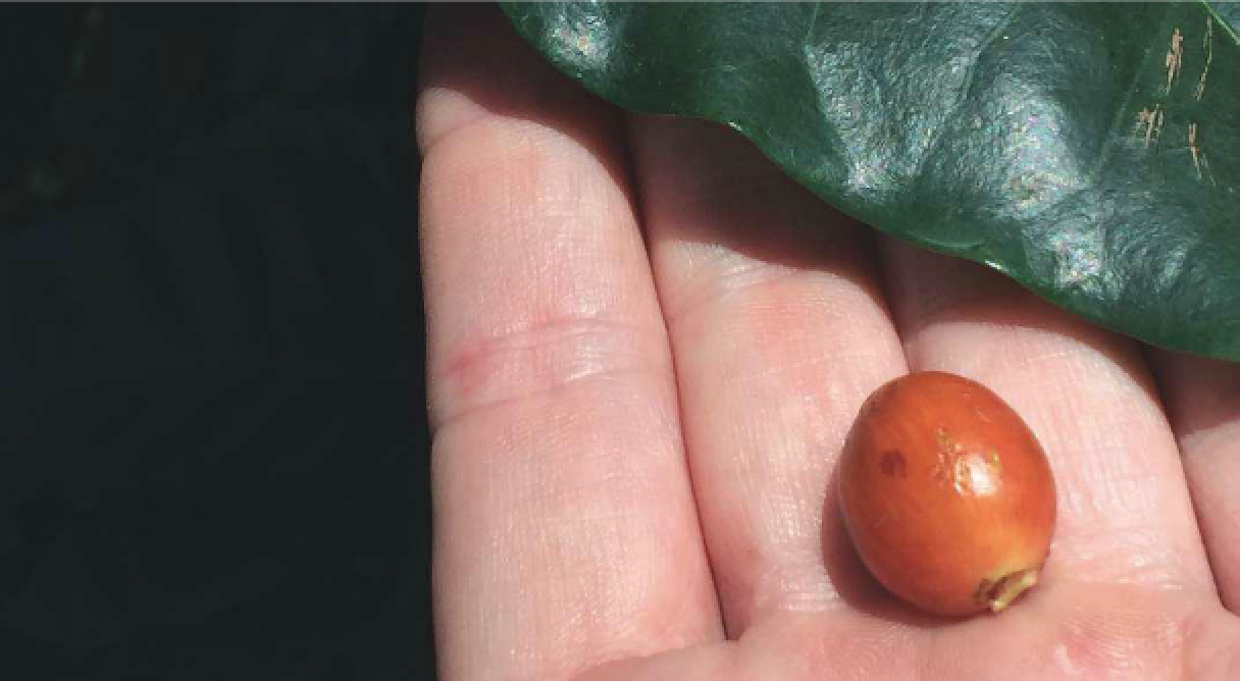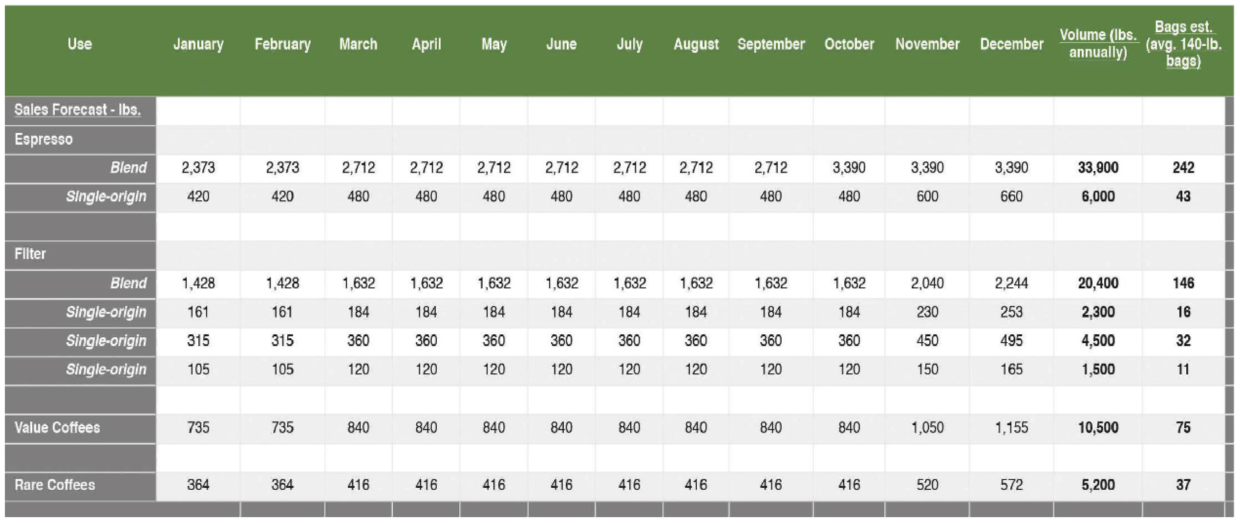(Editor’s note: This article written by Andy Newbom originally appeared in the July/August 2017 issue of Roast Magazine. Links have been added for context.)
Specialty coffee is a business. It’s a fun and rewarding business, but a business nonetheless, and all businesses must be built on a solid foundation of numbers. Numbers refer to finances, but also to every other aspect of the business. How many pounds per roasted batch do you yield? How many double shots per pound can you sell? What percentage of your sales are single-origins versus blends? What is your anticipated growth, and how much will you allocate for product development, mistakes or equipment issues? How many pounds of green coffee should you buy from Gloria Rodriguez’s Finca San Jose in El Salvador this year?
Numbers rule your business — so you should rule your numbers. Get them right and you have a solid foundation from which to grow and improve the world through coffee. Get them wrong and your business might not survive.

A solid plan that includes future buying forecasts can help you develop and maintain strong relationships with growing and importing partners. Photo courtesy of Andy Newbom.
When it comes to green coffee purchasing decisions, however, there is another question — a question unrelated to numbers — that is equally important. That simple question is, “Why?”
Why did you buy that yellow bourbon honey-processed El Salvador microlot? Why did you pay $6.38 per pound for it, and why on Earth did you buy 6,688 pounds of it? Even more importantly, why did you also buy 3,192 pounds of a honey-processed Guatemala microlot that fits almost exactly the same profile, price and use in your coffee lineup? And why don’t either of them work for your espresso blend?
The Importance of a Plan
In an article in the May/June 2017 issue of Roast (“Stick to the Plan: Why Roasters Shouldn’t Buy Coffee Off the Cupping Table”), I asserted that roasters should buy coffee based on the following criteria:
- For your company’s needs
- Based on a written strategic buying plan
- For your market and use
- Within your budget
In this article, we’ll delve deeply into the second point on that list: “Based on a written strategic buying plan.”
Every coffee roaster, regardless of size or volume, should have a clearly articulated coffee buying and selling plan with both historical and forecasted numbers. It should be written, and it should always be accessible. This forecast can take several forms and can range from simple to immensely complex, depending on your needs and volume. The form of the plan is not crucial; it’s the forming of the plan that is key. Whether you are a large regional wholesale-only roaster, a local cafe roaster or a private-label roaster, a clearly articulated plan will save you money, time and frustration.

Your buying plan should include specifics related to varieties, sensory attributes, certifications, price ranges and more. Photo courtesy of Andy Newbom.
To form a written coffee plan, a roaster must first define and organize its approach, desires, theories, philosophies and preferences. This is the why portion of the plan. It is the most important part and requires the most thought and decision making.
Some of the criteria that typically make up the overview of a coffee plan include:
- Will you buy for blends, single-origins or both? Why? Will you buy for espresso, filter or both? Why?
- Will you purchase certified, microlots, specialty, commercial, etc.?
- Will you focus on a few countries or regions, or several?
- What are your target price points and ranges (high-end, mid-range, value)? (and) What are your target sales price ranges?
- What flavors and attributes will you seek out and/or avoid?
- Are you buying for a single brand or line, or multiple?
If your plan is to be an accurate and relevant buying guide, you will need to ask and answer the preceding questions, and others, before you begin. They will help guide not only your coffee buying and selling plans, but your entire coffee business. In fact, asking the right questions is the single most important thing you can do for your business to succeed.
Time Travel
Your coffee buying plan should be like a time-travel document. It should allow you to look back at your past purchases, uses and schedules and use that data to improve future planning. Your coffee buying plan is a rolling forecast that goes back in time (as many years as you have had the plan) and should go forward at least two to three years using forecasted growth.
Forecasting three or more years out on your coffee buying needs may seem excessive, but rest assured you will be grateful for thinking ahead. Another use of the forecast beyond the current crop year is to give your importers and/or producer partners estimates of your probable coffee needs two to three years out, to help them better plan for your increasing needs. It might even help you secure exclusive lots in highly competitive markets.
Imagine the scenario where you are talking to your importer or producer partner about the coffees you need to buy this year. You tell them the number of bags, price ranges and quality levels, and they use that information to plan for the current harvest. Your needs are small but you hope to grow them over time.
Now imagine another coffee buyer of the same size approaches the importer or producer and proposes to buy the same coffee at about the same price using a rolling-forecast coffee buying plan. The roaster shows the seller its proposed purchases for the next three years, with some amount of growth built in.
Which coffee roaster is going to get the best coffee at the best price?
Plan the Plan
A plan is only as good as the information it includes. There are many criteria that guide your sourcing and purchasing decisions, but every coffee buying plan should include, at a minimum, the following:
- Use: espresso, blend, filter
- Price range: value, mid-range, high-end
- Attributes: flavor, acidity, body
- Certification: organic, fair trade, Rainforest Alliance, Utz, etc.
- Volume (in pounds or kilos, not bags)
The more information you include the better; however, these are key criteria that should be in every plan.
Use is simply how you plan to use each coffee. Are you looking to buy a coffee to be used primarily as espresso? If so, is it a single-origin espresso or part of a blend? If it is a component of a blend, is it the bottom half with heavier body, more chocolatey sweetness and toffee, or is it the sparkling sweet grape acidity pop on top of the blend? The answers to these questions will guide you to decidedly different coffees.
Price range is fairly straightforward; however, don’t fall into the trap of thinking every coffee has to fall into the same price range. Not only should you have different price points for different markets and uses, you can use differing price points to balance your overall coffee costs. For instance, you could buy a slightly lower-scoring value blend from a producer partner, which enables the farmer to sell his or her good but not great coffees to a trusted partner, and allows you to splurge on that farmer’s top-scoring microlot. This doesn’t need to be exact, but it should include an estimated price range for each coffee on your plan. Pay fair prices for quality and story. Give value where value is due, and you will achieve lasting success.
Attributes such as flavor, aftertaste, acidity and body are your most important coffee selection tools. Don’t just buy the highest-scoring coffees available. Instead, buy coffees that match the attributes you are seeking. Pay special attention to flavors, balance, sweetness and complexity, which are far more difficult to find than just screaming acidity.
Certification is the most cut and dried of your buying criteria, as it’s a simple check box, but always be sure to verify certification claims. If you don’t plan to require certified coffees, you can eliminate this criterion from your plan.

Cupping and tasting should be used as tools to find coffees that fit your strategic buying plan. Photo courtesy of Andy Newbom.
Volume seems like the simplest category, but it is the single most important one. For the buyer, it sets the total budget for each coffee and for the entire coffee buying plan year. For the importer and producers, it sets the total sale and, equally important, the potential forecasted sales revenue. Sharing this information helps build strong relationships that will set your business apart from the competition and give you a competitive advantage. Some key considerations concerning volume are seasonality, delivery windows, delivery months, shipping time and, of course, use. Always know whether each coffee has a specified season (a certain number of months after harvest, for example, but not all year) or whether you will carry it year-round. Try to plan for shipping delays and shortages while avoiding too much overlap.
Do not fall into the trap of forecasting in terms of bags. Weight per bag can vary from country to country, and all coffee at origin is organized by weight (sometimes lumped into local bag-like measurements such as the quintal). Using pounds or kilos allows for simple calculations when converting between parchment, raw green and export- quality green. Additionally, all your coffee is priced per pound, so this facilitates the simplest forecasting and cost analysis.
Figure 1 shows a hyper-simplified example of a coffee needs plan to guide buying decisions. It focuses on use to create a coffee needs list you can use to source and buy coffees to fit your plan. You can add as many espresso blends, single-origins and filter coffees as you need. Your specific attributes, price ranges and other criteria will vary based on your business plan, market and goals.
Plan the Tools
You can use a variety of tools to create and manage your plan. Many roasters use spreadsheets, which are relatively easy to use, flexible, can be shared and accessed easily — Numbers and Google Sheets both allow group sharing and editing, for example — and are simple to set up for rolling forecasts and history.
Some roasters use specialized planning or forecasting software tools. The specific tool is not as important as using it consistently. If you find a tool that looks super cool and is loaded with bells and whistles but you don’t use it consistently, your plan will not be effective.
The most important criteria to consider when choosing a tool to create and manage your plan are:
- Ease of use: Is it easy to use and simple to focus on the content rather than the process?
- Flexibility: Can you make changes easily?
- Access: Can it be shared and accessed from different devices/ locations?
- Time span: Can you roll forward and backward in time in the plan?

If you plan to offer coffees processed using different methods, be sure to make a place for them in your plan. Photo courtesy of Andy Newbom.
Create the Plan
The most common way to organize a coffee buying plan is to first create a coffee selling plan. The selling plan is a rolling forecast going at least 12 months ahead, though the more months the better. This plan should detail all the coffees you have sold in past months and think you can sell each month ahead, broken out by coffee type, need, brand and use. Keeping a sales log with details on weather events, holidays, and other external influences will help when anticipating futures sales forecasts.
Most roasters use their coffee needs plan (see Figure 1) to create this rolling sales forecast, detailing how many pounds they already sell or plan to sell each month for each type of coffee. Once you create this, you have a pretty solid forecast (and historical look) at your total coffee needs by category or type of coffee. This will be the basis for developing your coffee buying plan.
If you use a spreadsheet, a basic setup for the coffee selling plan could look like Figure 2, with the following organization:
- Left column: coffee types (espresso, filter, value, etc., based on the coffee needs plan shown in Figure 1)
- Top row: timeline, typically by month, showing sales in pounds
- Far-right columns: summaries, showing total pounds and total bags for each coffee type
This rolling forecast, updated with monthly actual sales and inventory, along with a constantly updated coffee needs plan, can ensure that (most of the time) you don’t buy too much or too little overall, and can help you plan your buying to fill all the needs in your lineup without overloading or under-filling any particular need.
You can, of course, make room in your plan for those superstars that jump off the cupping table and strike your fancy. In fact, if you buy spot coffees (coffee already received and stored at a domestic warehouse), you can include a specific percentage of inventory in your coffee needs plan for those. However, make sure the spot coffees you purchase fit your overall coffee plan, financial model and needs. Don’t buy a coffee just because it tastes good. Buy it because you can make a space for it in your plan.
Finally, combining your coffee needs plan with your rolling coffee sales forecast, you can create a coffee buying plan. For some roasters, this plan will be remarkably complex. For others, it will be relatively simple. It all depends on your business, goals and volumes. At its core, the coffee buying plan takes the coffees you need, in the volumes you think you can sell, and matches them to coffees you can buy to fit your needs. It must be a living document that is continuously updated, revised and clarified. Make it work for you to build a solid business.
Using the Plan
As an example of how to use your newly crafted plans, let’s look at the foundation coffee for the espresso blend shown in Figure 1: Coffee Needs Plan. The plan indicates that this coffee should be a lower-toned, rounded, dark chocolate type coffee, and not a Brazil. It also indicates a target price between $3.35 to $3.65 per pound green, and total espresso sales of 33,900 pounds over the next 12 months, leading to a target purchase of 18,000 pounds (53 percent of the blend) over the next 12 months.
With that in mind, you might decide you want to split this coffee into two purchases to keep it fresh, vibrant and seasonal. Let’s say you decide to buy 10,000 of the 18,000 total pounds from Veracruz, Mexico, covering your needs for 60 percent of the year. Then you decide to buy a Selva Central Peru to cover the other 40 percent. By keeping track of what you have purchased and what remains to be purchased on your coffee needs plan, and by keeping your coffee sales plan updated with actual sales numbers and updating forecasts based on those actual sales, you can manage your green buying and sales with precision and ensure your inventory, shipping and logistics meet your needs.
Done right, and optimized and customized for your business, this three-stage coffee plan will make your entire business run more smoothly and efficiently, with less risk and lower costs. Note that even the best of plans can break down when faced with the day-to-day realities of the coffee business. Assume that coffees, markets, prices, supplies, customers and demands will change, drastically and continuously. Build in some wiggle room to account for as much of this as you can.
Fundamentally, this process is centered on asking questions, and the first question you should ask about any coffee you consider buying is why? Why should you buy this coffee? Does it fit your plan? If so, where? What will you do with it, and how will you sell it?
As I always say, data only answers the questions you ask of it. Ask the right questions, and you can retain control of your coffee business.
Andy Newbom
Andy Newbom has spent the past 18 years working with producers, millers, exporters and importers at origin to improve the quality and profitability of specialty coffee throughout the supply chain. His passion and mission is to bring about a revolution in specialty coffee by improving quality and yields to build a massive market for good and great coffee, and to deliver sustainable prices throughout the coffee chain. Newbom was the co-founder of IPCoffees Specialty Imports, Barefoot Coffee Roasters, Finca Coffees and Brew Revolution Craft Brewery, along with his equally coffee-obsessed wife Nanelle Newbom, and one of the six founders of the Barista Guild of America.











Comment